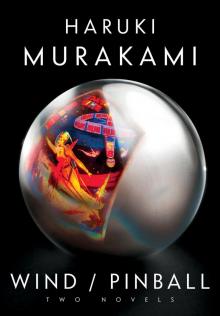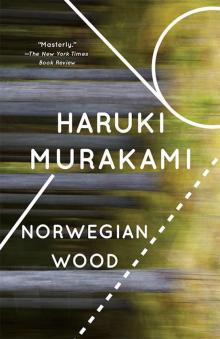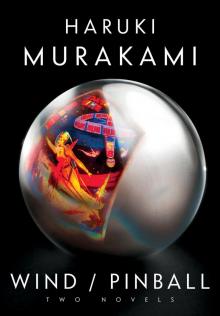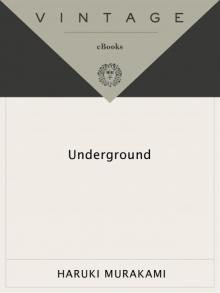- Home
- Haruki Murakami
Underground: The Tokyo Gas Attack and the Japanese Psyche Page 7
Underground: The Tokyo Gas Attack and the Japanese Psyche Read online
Page 7
When I opened my eyes, I saw a station attendant in a green uniform coming in and out. The floor was wet, too. The wet patch was maybe five meters away from me. The criminals had pricked their bags of sarin and got off at Shin-ochanomizu. But anyway I’d been fast asleep and hadn’t seen a thing. The police questioned me over and over about it, but what I didn’t see I didn’t see. They thought that sounded suspicious. I was traveling to Aoyama and the Aum headquarters are in Aoyama.
The train continued on to the next stop, Kokkai-gijidomae, where we all had to get off. No explanation was given over the PA, just, “This train is going out of service—all passengers please disembark.” But between Kasumigaseki and Kokkai-gijidomae I was really in pain. I was coughing, I couldn’t breathe. When we reached Kokkai-gijidomae there were people near me who couldn’t even move. One woman in her fifties had to be lifted off by the station attendants. There were maybe ten people in the car and some of them held handkerchiefs over their mouths, coughing.
“Hey, what’s going on here?” I thought, but I had to get to work. I had a whole list of things to do. Stepping out onto the platform, who knows how many people were squatting there? The station attendants had rounded up all those who were feeling sick, there must have been fifty in all. Two or three were completely immobilized, one or two lay stretched out on the platform.
Oddly enough, though, the atmosphere wasn’t tense at all. Even though I was feeling strange. I’d inhale and no breath would come. It was almost as if the air was running out. I could still walk, though, so I thought I was fine. Instead of joining the “sick” group, I just caught the next train. It came straightaway, but no sooner had I gotten on than my legs started to feel shaky. My eyes stopped working. Suddenly it was as if night had fallen. “Damn,” I thought, “I should have stayed back there with the others.”
When I got to Omote-sando Station, I asked the attendant, “I don’t know why I’m feeling so out of sorts … did something happen in the subway?” And he said, “There seems to have been an explosion at Hatchobori.” “There was something wrong with the train I was on just now, too,” I said, but this was explained away as “gasoline or something has been spilled inside.” Totally mixed-up information. Then I went to the stationmaster’s office and I told them, “I feel awful. I can hardly see,” but news had yet to reach Omote-sando Station. Their response was, “Why don’t you just sit down for a bit? Would you like a cold drink?” Very kind, but they didn’t have a clue.
“This is useless,” I thought, so I gave up and I went out above ground. It was a wonderful clear day, but everything was dark. “Uh-oh, this looks bad.” I went to a hospital, near the office, but when I got there I couldn’t really explain what had happened. “This is probably an emergency: I just left the subway and …” You know, I spelled it out as clearly as possible, but they couldn’t see me straightaway. I called the office: “I’m not feeling so good. I’ll be a little late.” In the end I waited there for three hours. Three hours and they didn’t do a damn thing! My breath was getting shorter and shorter, my eyesight dimmer and dimmer … I was going out of my mind, so I telephoned the Subway Authority, just to get some kind of explanation. After all, they had rounded up on the platform those people who were feeling ill. I wondered what had happened to them. But I couldn’t get through on the phone.
At 11:00 news came that it was sarin. Finally the doctors would have a look at me! They got the picture. Straightaway it was transfusions, hospitalization. I was their first sarin patient, so suddenly the doctors were fascinated. They gathered around, poking me all over the place for symptoms, chatting among themselves: “See, this is what it does.” I was in there for three days.
I was so exhausted I slept really well, but the three months after that were tough. I was tired all the time. Try and do something and I’d be worn out. My eyes had gone, my focus was blurry and my field of vision was tiny. My job involves a lot of driving, but after dark I couldn’t see a thing. My vision’s normally okay, but I couldn’t even make out street signs. And if I can’t read a computer screen I can’t do business.
I probably went a little funny in the head, too. Seriously. I went around telling people, “Something’s out there. You’ll see, something strange is going to happen.” I was buying survival gear at camping stores (laughs). After I came back to normal, I thought, what a fool I’d been … but at the time I was deadly serious. Now, what am I going to do with a survival knife?
It’s odd, but I didn’t feel anything like anger. Of course, it makes me angry to think of those who died. It makes me especially sad to think of the dead station attendants who carried out the sarin. If they hadn’t been there, I might have died too. But I don’t feel any personal hatred or bitterness toward the criminals. It feels more like I had an accident. Maybe you were expecting another response?
Either way, I couldn’t stand the media coverage of Aum. I don’t even want to look at it. Yes, you could say it’s reinforced my mistrust of the media. The long and the short of it is, everyone loves a scandal. They just enjoy saying, “Oh, what a shame.” I’ve even stopped reading magazines.
* Ikuo Hayashi was sentenced to life imprisonment. At the time of going to press he was serving time in prison and Tomomitsu Niimi was still on trial. [Tr.]
* Numbers in parentheses refer to the age of the interviewee at the time of the Tokyo gas attack. [Tr.]
* This woman refused to be interviewed.
TOKYO METROPOLITAN SUBWAY: MARUNOUCHI LINE (Destination: Ogikubo)
TRAIN A777
The team of Ken’ichi Hirose and Koichi Kitamura planted sarin on a westbound Marunouchi Line train destined for Ogikubo.
Born in Tokyo in 1964, Hirose was 30 years old at the time. After graduating from Waseda High School, a preparatory school for the prestigious Waseda University, he enrolled at the university’s Engineering department, from which he graduated in Applied Physics at the top of a class of one hundred. He’s the very model of an honor student. In 1989 he completed his postgraduate studies, only to spurn offers of employment and take vows instead.
He became an important member of the Aum cult’s Chemical Brigade in their Ministry of Science and Technology. Along with fellow perpetrator Masato Yokoyama, Hirose was a key figure in their secret Automatic Light Weapon Development Scheme. A tall, serious-looking youth, he seems rather more boyish than his 32 years. In court he chooses his words carefully and speaks quietly and to the point.
The morning of March 18, Hirose received orders from his Ministry of Science and Technology superior Hideo Murai to plant sarin on the subway. “I was extremely surprised,” he said later in court. “I shuddered to think of all the victims this would sacrifice. On the other hand, I knew I couldn’t be well-versed enough in the teachings to be thinking like that.” In awe of the gravity of his mission, he felt a strong “instinctual resistance,” but his adherence to Aum’s teachings was even stronger. While he now admits his error, he claims he realistically had neither the liberty nor the will to disobey orders from above—that is, as he says himself, from Shoko Asahara.
Hirose was ordered to board the second car of an Ogikubo-bound Marunouchi Line train at Ikebukuro Station. At Ochanomizu Station, he would poke holes in two packets of sarin and be picked up by Kitamura’s car waiting outside. The train number was A777. Detailed instructions were provided by Hirose’s “Big Brother,” Yasuo Hayashi. After twenty days of training at Kamikuishiki Village, Hirose finally poked so hard with his umbrella that he bent the tip.
Leaving the Aum ajid in Shibuya, west central Tokyo, at 6:00 on the morning of March 20, Hirose and Kitamura drove to Yotsuya Station. There Hirose boarded a westbound Marunouchi Line train for Shinjuku, then changed to the Saikyo Line northbound for Ikebukuro. He bought a copy of a sports tabloid at a station kiosk and wrapped the sarin packets in it. He waited around before boarding the appointed Marunouchi Line train, standing by the middle door of the second car. But when it was time to release the sarin, the newspaper wrapp
ing made such a noise it drew the attention of a nearby schoolgirl—or at least Hirose thought it had.
Unable to bear the mounting tension, he got off the train at Myogadani or Korakuen Station and stood on the platform. Overwhelmed by the horror of what he had been commanded to do, he was filled with an intense desire to leave the station without going through with it. He confessed to feeling “envious of the people who could just walk out of there.” In retrospect, that was the crucial moment when things might have been very different. Had he simply left the station, hundreds of people would have been spared a major derailment in their lives …
But Ken’ichi Hirose gritted his teeth and overcame his doubts. “This is nothing less than salvation,” he told himself. The act of doing it is what matters, and besides, it’s not just him, all the others are doing the same thing too. He couldn’t let the others down. Hirose got back on the train, taking another car, the third, to avoid the inquisitive schoolgirl. As the train approached Ochanomizu Station, he pulled the packet of sarin out of his bag and dropped it unobtrusively on the floor. The newspaper wrapper fell off as he did so and the plastic packet was exposed, but by then he didn’t care. He didn’t have time to care. He repeated an Aum mantra under his breath in order to steel himself, then, just as the doors opened at Ochanomizu, he banished all thoughts and stabbed at the bag with the tip of his umbrella.
Before getting into Kitamura’s waiting car, Hirose rinsed the umbrella tip with some bottled water and tossed it into the trunk. Despite being extremely careful in his movements, he soon showed the unique symptoms of sarin poisoning. He couldn’t speak properly and breathing was difficult. His right thigh began to twitch uncontrollably.
Hirose hurriedly injected himself in the thigh with the atropine sulphate given him by Ikuo Hayashi. With his excellent scientific background, Hirose knew how deadly sarin could be, but it was far more toxic than he had expected. The thought crossed his mind: “What if I just die like this?” He remembered Ikuo Hayashi’s advice: “At the first sign of any physical abnormalities, report to Aum Shinrikyo Hospital in Nakano for immediate medical treatment.” Hirose had Kitamura drive the car to Nakano, but was completely caught off-guard to find the doctors there knew nothing about the secret sarin drop. They returned swiftly to the Shibuya ajid, where Ikuo Hayashi administered emergency care.
Back at Kamikuishiki Village, Hirose and Kitamura joined the other perpetrators to deliver to Asahara the message: “Mission accomplished.” Whereupon Asahara commended them, saying, “Trust the Ministry of Science and Technology to get the job done.” When Hirose confessed to having changed to another car because he thought he’d been noticed, Asahara seemed to accept his explanation: “I was following everyone’s astral projections the whole time,” he said, “and I thought Sanjaya’s (Hirose’s cult name) astral projection seemed dark, as though something had happened. So that’s what it was.”
“The teachings tell us that human feelings are the result of seeing things in the wrong way,” said Hirose. “We must overcome our human feelings.” He had succeeded in puncturing two plastic packets, releasing 900 milliliters of liquid sarin onto the floor. As well as the one passenger who died, 358 were seriously injured.
At Nakano-sakaue Station a passenger reported that someone had collapsed. Two severe casualties were carried out: one died; the other, “Shizuko Akashi,” * was temporarily reduced to a vegetative state. Meanwhile, a station attendant, Sumio Nishimura, scooped up the sarin on board and cleared it from the station (see this page). But the train itself continued on its way, the car floor still soaked with liquid sarin.
At 8:38 the train reached Ogikubo, the end of the line. New passengers got on and the train headed back eastward in the opposite direction. Passengers in the eastbound train complained of feeling ill. Several station attendants that had boarded the train at Ogikubo also mopped the floor, but they too gradually became unwell and had to be rushed to the hospital. The train was taken out of service two stops later at Shin-koenji Station. †
“I felt like I was watching a program on TV”
Mitsuo Arima (41)
Mr. Arima lives south of Tokyo in Yokohama. His clean-cut features, smart clothes, and bearing give him a youthful appearance. He defines himself as optimistic and fun-loving; eloquent, but never dogmatic. It’s not until you sit and talk to him that you realize he has one foot in middle age. After all, 40 is a turning point, an age when people begin to ponder the meaning of it all.
Married with two children, Mr. Arima works for a cosmetics company. He and his colleagues play in a band for fun. He plays guitar. Due to commitments at work, Mr. Arima had the bad luck to catch the Marunouchi Line—which he doesn’t usually take—and get gassed.
Actually, the whole week before I’d been down with the flu. That was the first time in my adult life I’d ever taken to my bed. I’m never ill.
So there I was, going back to work that day after my absence, which is why I wanted to get to the office a little early, to make up for lost time (laughs). I left the house ten minutes earlier than usual.
I always sit down and have a leisurely read of the newspaper on the Yokohama Line going west to the Hachioji office, but that day it just so happens I was supposed to go to the downtown Shinjuku office for a special meeting of regional managers. I planned to spend the morning in Shinjuku, then put in an appearance at Hachioji.
The meeting began at 9:45. I left the house before 7:00, taking the Yokosuka Line up to Shimbashi, then the Ginza Line to Akasakamitsuke, then changed to the Marunouchi Line for Shinjuku-gyoemmae: travel time, an hour and a half. The Marunouchi Line clears out after Akasaka-mitsuke, so I’m assured of a seat. But that day, I sit down and straightaway I notice an acid smell. Okay, trains often smell funny, but this was no ordinary smell, let me tell you. I remember a lady sitting across from me covering her nose with a handkerchief, but otherwise there was nothing obviously wrong. I’m not even sure that smell was sarin. It’s only later I thought back, “Ah, so that’s what it was.”
I got off at Shinjuku-gyoemmae, except it was incredibly dark, like somebody had switched off all the lights. It had been a bright day when I left home, but when I exited above ground everything was dim. I thought the weather had taken a turn for the worse, but I looked up and there wasn’t a cloud in the sky. I was taking a hay-fever remedy at the time, so I thought it might be a reaction to the drug; It was different from my usual, so maybe this was a side effect.
But everything was still dark when I reached the office and I felt so lethargic I just sat in a daze at my desk, gazing out of the window. The morning meeting ended and everyone else went out for lunch. But everything was still dark and I had no appetite. I didn’t feel up to talking to anyone. So I ate quietly alone and then I broke out in a sweat. The TV was on in the ramen noodle shop and it’s round-the-clock news about the gas attack. The others tease me, saying, “Hey, maybe you have sarin poisoning,” but I knew it was the hay-fever remedy, so I just laughed along.
The meeting started again in the afternoon, but I’m not at all better. I decided to get examined by a hay-fever specialist. I excused myself from the meeting at 2:00. At that point I was starting to think, “Hey, what if it is sarin?”
For peace of mind, I decided to go to the local doctor near my home, the one who prepared the new hay-fever remedy. It was still a toss-up between hay-fever remedy or sarin poisoning. So I went all the way back to Yokohama, but when he heard I’d been on the subway before I came down with the symptoms he tested my pupils and recommended immediate hospitalization.
He took me by ambulance to Yokohama City College Hospital. I was able to get out of the ambulance and walk by myself, so my symptoms were slight then. But at night the headaches started. Around midnight a huge dull thud of pain. I called over the nurse, and she gave me an injection. The headache wasn’t a sharp shooting pain, it squeezed tight and hard like a vise for a good hour. Maybe this is it, I thought, but soon the pain subsided, and I was thinking, “Yeah, I�
�ll pull through.”
The eyedrops they’d given me to dilate my pupils worked a bit too well, though, and now my pupils were wide open. The next day when I woke up everything was so bright… so they put up paper all around my bed to block out the glare. Thanks to that it was another day in the hospital before my pupils were normal again.
In the morning my family visited. I was still in no condition to read the newspaper, but I found out how serious the attack was. People died. I might have been killed myself. Oddly enough I didn’t feel any sense of crisis. My reaction was, “Well, I’m okay.” I’d been right at the epicenter, but instead of shuddering at the death toll, I felt like I was watching a program on TV, as if it were somebody else’s problem.
It was only much later that I began to wonder how I could have been so callous. I ought to have been furious, ready to explode. It wasn’t until the autumn that it really sank in, little by little. For instance, if someone had fallen down right in front of me, I like to think I’d have helped. But what if they fell fifty yards away? Would I go out of my way to help? I wonder. I might have seen it as somebody else’s business and walked on by. If I’d gotten involved I’d have been late for work …
Since the war ended, Japan’s economy has grown rapidly to the point where we’ve lost any sense of crisis and material things are all that matters. The idea that it’s wrong to harm others has gradually disappeared. It’s been said before, I know, but this really brought it home to me. What happens if you raise a child with that mentality? Is there any excuse for this kind of thing?

 Sputnik Sweetheart
Sputnik Sweetheart Dance Dance Dance
Dance Dance Dance The Wind (1) and Up Bird Chronicle (2)
The Wind (1) and Up Bird Chronicle (2) Blind Willow, Sleeping Woman
Blind Willow, Sleeping Woman Absolutely on Music: Conversations With Seiji Ozawa
Absolutely on Music: Conversations With Seiji Ozawa Norwegian Wood
Norwegian Wood South of the Border, West of the Sun
South of the Border, West of the Sun Kafka on the Shore
Kafka on the Shore Men Without Women
Men Without Women After Dark
After Dark Hard-Boiled Wonderland and the End of the World
Hard-Boiled Wonderland and the End of the World 1q84
1q84 The Wind-Up Bird Chronicle
The Wind-Up Bird Chronicle Underground: The Tokyo Gas Attack and the Japanese Psyche
Underground: The Tokyo Gas Attack and the Japanese Psyche Vintage Murakami
Vintage Murakami The Elephant Vanishes: Stories
The Elephant Vanishes: Stories Colorless Tsukuru Tazaki and His Years of Pilgrimage
Colorless Tsukuru Tazaki and His Years of Pilgrimage First Person Singular
First Person Singular After the Quake
After the Quake A Wild Sheep Chase
A Wild Sheep Chase What I Talk About When I Talk About Running
What I Talk About When I Talk About Running Birthday Girl
Birthday Girl The Elephant Vanishes
The Elephant Vanishes Norwegian Wood (Vintage International)
Norwegian Wood (Vintage International) Wind/Pinball
Wind/Pinball Norwegian Wood Vol 1.
Norwegian Wood Vol 1. Underground
Underground Colorless Tsukuru Tazaki and His Years of Pilgrimage: A novel
Colorless Tsukuru Tazaki and His Years of Pilgrimage: A novel Killing Commendatore
Killing Commendatore Absolutely on Music
Absolutely on Music